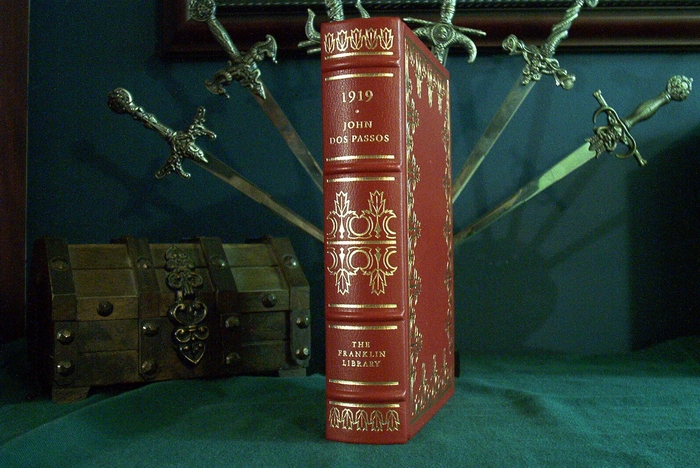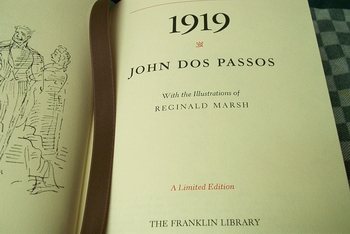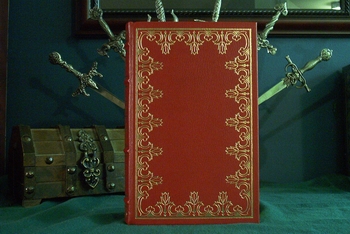Easton Press John Dos Passos books
The Shackles of Power by John Dos Passos - Library of American History - 1988The 42nd Parallel - Library of Famous Editions - 1994
Franklin Library John Dos Passos books
Writer John Dos Passos
John Dos Passos (1896–1970) was an American novelist, essayist, and playwright, best known for his significant contributions to 20th-century American literature. Born on January 14, 1896, in Chicago, Illinois, Dos Passos came from a well-educated family and was exposed to literature and the arts from an early age. Dos Passos initially studied architecture at Harvard University but soon discovered his passion for writing. He volunteered for the ambulance service during World War I, an experience that deeply influenced his worldview and later found its way into his works. After the war, Dos Passos returned to the United States and began his literary career.
In the 1920s, Dos Passos became associated with the Lost Generation, a term used to describe the disillusioned writers who emerged from the aftermath of World War I. His first major success came with the publication of his novel Three Soldiers (1921), a critical exploration of the impact of war on individuals. However, it was with his groundbreaking U.S.A. Trilogy that Dos Passos secured his place in American literature. The U.S.A. Trilogy, comprising The 42nd Parallel (1930), 1919 (1932), and The Big Money (1936), is a sprawling narrative that combines fiction, newsreels, biographies, and stream-of-consciousness techniques to depict the complex social and political landscape of the early 20th century. Dos Passos aimed to capture the multifaceted nature of American society by incorporating various narrative styles and perspectives.
The Big Money is the concluding volume of John Dos Passos's U.S.A. Trilogy, published in 1936. This monumental work, which also includes The 42nd Parallel (1930) and 1919 (1932), stands as one of the most ambitious literary undertakings of the early 20th century. The trilogy is a panoramic exploration of American life, encompassing the years leading up to and following World War I. In The Big Money, Dos Passos continues his innovative narrative technique, incorporating a variety of literary forms such as stream-of-consciousness, biographical sketches, and newsreels. The novel is structured into four sections: Newsreel, Camera Eye, Biography, and The Body of an American. The Big Money explores the impact of modern industrialization, the economic disparity between social classes, and the changing cultural landscape of America. Dos Passos delves into the lives of his characters, intertwining their personal struggles with the broader historical context. The novel captures the upheavals and uncertainties of the post-World War I period, including the economic boom of the 1920s and the subsequent Great Depression.
Dos Passos's critique of American society is evident throughout the trilogy. He addresses issues such as the dehumanizing effects of capitalism, the erosion of individual identity in a mass society, and the challenges faced by ordinary people in the pursuit of the elusive "big money." The U.S.A. Trilogy as a whole left an indelible mark on American literature, praised for their innovative narrative techniques and their exploration of the complexities of 20th-century American life. The trilogy remains a significant and influential work that continues to be studied for its literary merit and historical insight.
In addition to his novels, Dos Passos was an outspoken political activist. He went through a period of left-wing political engagement, during which he supported socialist and communist causes. However, his political views evolved over time, and he became increasingly critical of communism, aligning himself more with conservative ideologies in his later years. Dos Passos continued to write prolifically throughout his career, producing novels, essays, and plays. Some of his other notable works include Manhattan Transfer (1925), District of Columbia (1952), and Midcentury (1961). Despite the changing literary landscape and political climate, Dos Passos remained a distinctive and influential voice in American literature. John Dos Passos passed away on September 28, 1970, leaving behind a rich body of work that continues to be studied and appreciated for its innovative narrative techniques and its exploration of the complexities of American society.
The 42nd Parallel - The U.S.A. Trilogy Book 1
With his U.S.A. trilogy, comprising The 42nd Parallel, 1919, and The Big Money, John Dos Passos is said by many to have written the great American novel. While Fitzgerald and Hemingway were cultivating what Edmund Wilson once called their "own little corners," John Dos Passos was taking on the world. Counted as one of the best novels of the twentieth century by the Modern Library and by some of the finest writers working today, U.S.A. is a grand, kaleidoscopic portrait of a nation, buzzing with history and life on every page.
The trilogy opens with The 42nd Parallel, where we find a young country at the dawn of the twentieth century. Slowly, in stories artfully spliced together, the lives and fortunes of five characters unfold. Mac, Janey, Eleanor, Ward, and Charley are caught on the storm track of this parallel and blown New Yorkward. As their lives cross and double back again, the likes of Eugene Debs, Thomas Edison, and Andrew Carnegie make cameo appearances.
1919 - The U.S.A. Trilogy Book 2
With 1919 , the second volume of his U.S.A . trilogy, John Dos Passos continues his "vigorous and sweeping panorama of twentieth-century America" ( Forum ), lauded on publication of the first volume not only for its scope, but also for its groundbreaking style.
Again, employing a host of experimental devices that would inspire a whole new generation of writers to follow, Dos Passos captures the many textures, flavors, and background noises of modern life with a cinematic touch and unparalleled nerve.
1919 opens to find America and the world at war, and Dos Passos's characters, many of whom we met in the first volume, are thrown into the snarl. We follow the daughter of a Chicago minister, a wide-eyed Texas girl, a young poet, a radical Jew, and we glimpse Woodrow Wilson, Theodore Roosevelt, and the Unknown Soldier. 1919 provides an incomparable portrait of America from the turn of the century to the Depression of 1929.
The Shackles of Power - Three Jeffersonian Decades
As much a general chronicle of the years 1807 to 1831, as a biography, it is a historical montage that interweaves the story of Jefferson with other figures of the era.



Comments
Post a Comment
Share your best book review and recommendation